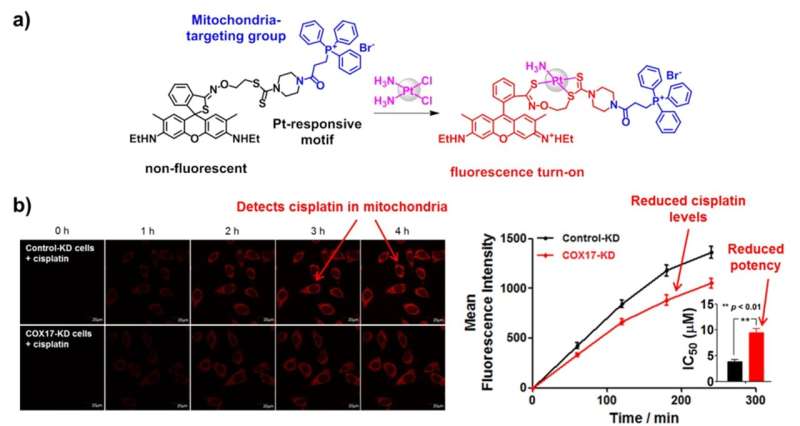A mitochondria-targeted fluorescent probe for cisplatin

NUS chemists have developed a mitochondria-targeted fluorescent probe for real-time imaging of clinically important anticancer drug cisplatin in live cancer cell models.
Since its discovery in 1965, cisplatin has become one of the most important chemotherapeutic agents in clinical use. It forms part of a class of platinum(II) anticancer agents and is being used widely for treatment of a variety of malignancies such as testicular, ovarian, lung and colorectal cancers. Despite cisplatin's potency and widespread use, there remain considerable gaps in the understanding of its mechanism of action. It is generally accepted that cisplatin acts by binding to genomic deoxyribonucleic acid (DNA) in the nucleus, which inhibits ribonucleic acid (RNA) transcription and induces cellular apoptosis. However, the role of other cellular components cannot be ruled out, particularly since less than 1% of cisplatin administered results in genomic DNA-binding. Mitochondria have been previously proposed to be an important cellular target for cisplatin because it contains unique mitochondrial DNA, distinct from those found in the nucleus.
Prof ANG Wee Han and his research team from the Department of Chemistry, National University of Singapore have developed a mitochondria-targeted fluorescent probe known as Rho-Mito that is able to detect the presence of cisplatin selectively and with good precision within the mitochondria (see Figure (a)). The usual method of quantifying cisplatin is to measure the platinum content in cancer cells through elemental analysis. It is a laborious process involving isolation of mitochondria and acid digestion, which reduces experimental precision. Furthermore due to its destructive nature, this method can only be performed as a single time point measurement. It is not able to provide continuous measurements in living cells, which is required when studying platinum accumulation over time. With Rho-Mito, the group was able to perform real-time monitoring of cisplatin uptake in the mitochondria for the first time in living cells using fluorescence microscopy (see Figure (b)).
Using Rho-Mito in their live-cell fluorescence imaging experiments, the group discovered that cisplatin accumulation in mitochondria is significantly reduced after gene knockdown of COX17, a protein whose primary role is to transport copper to mitochondria. Remarkably, decrease in mitochondrial cisplatin levels in COX17-depleted cells correlated with a reduction in the overall potency of cisplatin. A similar trend was also observed with other platinum(II) analogs. Through these laboratory experiments, the researchers show that mitochondria is an important cellular component targeted by cisplatin and other platinum(II) compounds.
Prof Ang said, "We believe Rho-Mito is a useful tool which can empower researchers to better understand the mechanism of action of platinum-based drugs and pave the way for the design of more targeted and effective platinum drugs."
Moving forward, the team plans to expand the library of targeting probes for research on the localisation of platinum-based drugs in other cellular compartments within cancer cells.
More information: Jun Xiang Ong et al, A Cisplatin‐Selective Fluorescent Probe for Real‐Time Monitoring of Mitochondrial Platinum Accumulation in Living Cells, Angewandte Chemie International Edition (2020). DOI: 10.1002/anie.202010951
Journal information: Angewandte Chemie International Edition
Provided by National University of Singapore




















